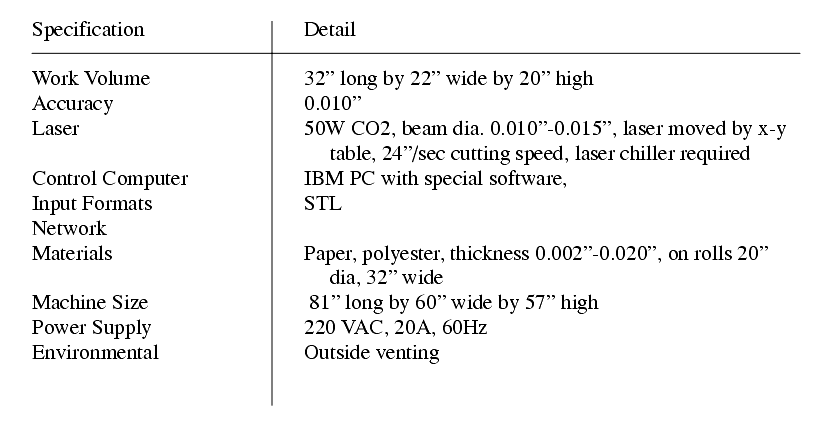
|
|
|
66.7 LAMINATE OBJECT MODELING (LOM)
������������Invented by Michael Feygin 1985, marketed by Helisys as LOM 1015 and LOM 2030. Also manufactured by Paradigm and Sparx AB as HotPlot
uses thin sheets of material (most notably paper and polystyrene) that has a heat activated adhesive on one side. Sheets are piled up one at a time, and heat is used to melt sheets together. A laser then cuts the sheet into thin sections that form the slice.
Slice thickness depends on material and ranges from 0.002" to 0.02". Materials in use are,
The laser uses the typical x-y and optics systems for the laser
More than one layer can be cut at once, but the accuracy decreases as the number of layers increases.
As material is cut, it is not removed. Material that is to be discarded is cut into "tiles". There are chunks of material that will support the part, and are easily removed to recover the part.

When complete the part is in the middle of a block. Outside there is a "wall" to support the tiles, and in turn the tiles support the parts.
A heated roller compresses the laminate to the other layers. The thickness is harder to control, so the height of the material is measured each time to ensure accuracy.
The final part requires careful removal from the tiles, and is finally sealed to keep moisture out, and prevent layer separation.
***************** Include LOM process photos
The system uses a CO2 laser, and the cuts are done at varied powers and speeds. Note that these cuts are not done in raster lines such as other techniques
The other laser positioning systems operate differently, in this case the mirrors are rotated, which is better suited to drawing vectors, as opposed to rasters.
- no chemical changes, and minimal heating, so the shrinkage is trivial, and stress induced deformation is very small.
- removal of the tiles can be difficult because the laser cuts through the layers, not between them. This requires schemes to weaken material layers that are at a solid/air interface. Cross hatching is used to "burn-out" and weaken materials
The machine costs are itemized below,

Accuracy is +/- 0.002" in x-y and +/- 0.001" in z
time required is hours to days
wax can be used to add fillets
Investment Casting (one shot only)
making RTV Silicone Rubber Molds
Selected specifications are given for a LOM 1015,

Selected specifications are given for a LOM 2030,

Search for More: |

Custom Search
|

|